Ultra-Fast Heating Treatment Effect on Microstructure, Mechanical Properties and Magnetic Characteristics of Non-Oriented Grain Electrical Steels
Abstract
1. Introduction
2. Materials and Methods
3. Results and Discussions
3.1. Effect of Process Parameter on Microstructural Evolution
3.1.1. Conventional Annealing Heat Treatment
3.1.2. Ultra-Fast Heating Treatment
3.2. Effect of Microstructural Evolution on Mechanical Properties
3.3. Magnetic Measurements Results
4. Conclusions
- The comparison between the microstructures of the samples after conventional annealing, industrial reference annealing, and UFH treatment confirmed that innovative rapid annealing produced a severe grain refinement, with the grain size of UFH samples two times smaller;
- with the UFH cycle, conducted with P = 80%, Tpeak = 1000 °C and HR: 254 °C/s, it was possible to achieve tensile properties (Rm = 537 MPa, RpL: 408 MPa, RpH: 413 MPa, and A: 25%) comparable with an industrially produced M270-50 steel;
- the magnetic properties evaluated for the same sample that was UFH treated (P = 80%, Tpeak = 1000 °C, and HR: 254 °C/s), showed results comparable with industrially produced NGO steel grade M310-50A.
Author Contributions
Funding
Data Availability Statement
Conflicts of Interest
References
- Di Schino, A.; Testani, C. Corrosion Behavior and Mechanical Properties of AISI 316 Stainless Steel Clad Q235 Plate. Metals 2020, 10, 552. [Google Scholar] [CrossRef]
- Di Schino, A.; Gaggiotti, M.; Testani, C. Heat Treatment Effect on Microstructure Evolution in a 7% Cr Steel for Forging. Metals 2020, 10, 808. [Google Scholar] [CrossRef]
- Miranda-Pérez, A.F.; Rodríguez-Vargas, B.R.; Calliari, I.; Pezzato, L. Corrosion Resistance of GMAW Duplex Stainless Steels Welds. Materials 2023, 16, 1847. [Google Scholar] [CrossRef]
- Stornelli, G.; Gaggia, D.; Rallini, M.; Di Schino, A. Heat Treatment Effect on Maraging Steel Manufactured by Laser Powder Bed Fusion Technology: Microstructure and Mechanical Properties. Acta Metall. Slovaca 2021, 27, 122–126. [Google Scholar] [CrossRef]
- Gomes Landgraf, F.J. Nonoriented Electrical Steels. In Linking Science and Technology for Global Solutions; Springer: Orlando, FL, USA, 2012. [Google Scholar]
- Steiner Petrovic, D. Non-Oriented Electrical Steel Sheets. Mater. Technol. 2010, 44, 317–325. [Google Scholar]
- JFE Steel Corporation (Electrical Steel Business Planning Department). Electrical Steels for EV Traction Motors in JFE Steel; JFE Technical Report No. 27; JFE Steel Corporation: Tokyo, Japan, 2022. [Google Scholar]
- Fujimura, H.; Hirayama, R.; Wajima, K.; Yamazaki, S. Nippon Steel Technical Report No. 122; Nippon Steel: Tokyo, Japan, 2019. [Google Scholar]
- Enokizono, M.; Suzuki, T.; Sievert, J.D.; Xu, J. Rotational power loss of silicon steel sheet. IEEE Trans. Magn. 1990, 26, 2562–2564. [Google Scholar] [CrossRef]
- Senda, K.; Uesaka, M.; Yoshizaki, S.; Oda, Y. Electrical Steels and Their Evaluation for Automobile Motors. World Electr. Veh. J. 2019, 10, 31. [Google Scholar] [CrossRef]
- Faba, A.; Riganti Fulginei, F.; Quondam Antonio, S.; Stornelli, G.; Di Schino, A.; Cardelli, E. Hysteresis modelling in additively manufacturing FeSi magnetic components for electrical machines and drives. IEEE Trans. Ind. Electron. 2023, 26, 2562–2564. [Google Scholar] [CrossRef]
- Stornelli, G.; Faba, A.; Di Schino, A.; Folgarait, P.; Ridolfi, M.; Cardelli, E.; Montanari, R. Properties of additively manufactured electric steel powder cores with increased Si content. Materials 2021, 14, 1489. [Google Scholar] [CrossRef]
- Rodriguez-Vargas, B.R.; Stornelli, G.; Folgarait, P.; Ridolfi, M.R.; Miranda Pérez, A.F.; Di Schino, A. Recent Advances in Additive Manufacturing of Soft Magnetic Materials: A Review. Materials 2023, 16, 5610. [Google Scholar] [CrossRef]
- Di Schino, A.; Stornelli, G. Additive manufacturing: A new concept for end users. The case of magnetic materials. Acta Metall. Slovaca 2022, 28, 208–211. [Google Scholar] [CrossRef]
- Sidor, J.J.; Verbeken, V.; Gomes, G.; Schneider, S.; Rodriguez Calvillo, P.; Kestens, L.A.I. Through process texture evolution and magnetic properties of high Si non-oriented electrical steels. Mater. Charact. 2012, 71, 49–57. [Google Scholar] [CrossRef]
- Hawezy, H. The influence of silicon content on physical properties of non-oriented silicon steel. Mater. Sci. Technol. 2017, 33, 1560–1569. [Google Scholar] [CrossRef]
- Lee, K.M.; Park, P.; Huh, H.; Kim, K.; Engler, E. Effect of texture and grain size on magnetic flux density and core loss in non-oriented electrical steel containing 3.15% Si. J. Magn. Magn. Mater. 2014, 354, 324–332. [Google Scholar] [CrossRef]
- Ren, Q.; Hu, Z.; Cheng, L.; Zhang, L. Effect of rare earth elements on magnetic properties of non-oriented electrical steels. J. Magn. Magn. Mater. 2022, 560, 169624. [Google Scholar] [CrossRef]
- Mehdi, M.; He, Y.; Hilinski, E.J.; Kar, N.C.; Edrisy, A. Non-oriented electrical steel with core losses comparable to grain-oriented electrical steel. J. Magn. Magn. Mater. 2019, 491, 165597. [Google Scholar] [CrossRef]
- Fischer, O.; Schneider, J. Influence of deformation process on the improvement of non-oriented electrical steel. J. Magn. Magn. Mater. 2003, 254–255, 302–306. [Google Scholar] [CrossRef]
- Ferreira-De Dafè, S.S.; Da Costa-Paolinelli, S.; Cota, A.B. Influence of thermomechanical processing on shear bands formation and magnetic properties of a 3% Si non-oriented electrical steel. J. Magn. Magn. Mater. 2011, 323, 3234–3238. [Google Scholar] [CrossRef]
- He, Q.; Zhu, C.; Liu, Y.; Wen Yan, E.; Wan, W.; Li, L. Effect of annealing temperature on the properties of phosphorus micro-alloyed non-oriented electrical steels. J. Mater. Res. Technol. 2023, 23, 4454–4465. [Google Scholar] [CrossRef]
- Stocker, A.; Prahl, U.; Kawalla, R. Impact of hot rolling condition on microstructure, texture, and magnetic properties of ferritic Fe-2.4wt.% Si non-oriented electrical steel. In Proceedings of the International Conference on Magnetism and Metallurgy, Milan, Italy, 13–15 June 2022. [Google Scholar]
- An, L.; Wang, Y.; Song, H.; Wang, G.; Liu, H. Improving magnetic properties of non-oriented electrical steels by controlling grain size prior to cold rolling. J. Magn. Magn. Mater. 2019, 491, 165636. [Google Scholar] [CrossRef]
- Sidor, Y.; Kovac, F. Microstructural aspects of grain growth kinetics in non-oriented electrical steels. Mater. Charact. 2005, 55, 1–11. [Google Scholar] [CrossRef]
- Shimanaka, H.; Ito, Y.; Matsumura, K.; Fukuda, B. Recent development of non-oriented electrical steel sheets. J. Magn. Magn. Mater. 1982, 26, 57–64. [Google Scholar] [CrossRef]
- Liu, H.; Li, H.; Wang, H.; Liu, Y.; Gao, F.; An, L.; Zhao, S.; Liu, Z.; Wang, G. Effects of initial microstructure and texture on microstructure, texture evolution and magnetic properties of non-oriented electrical steel. J. Magn. Magn. Mater. 2016, 406, 149–158. [Google Scholar] [CrossRef]
- Jiao, H.T.; Xu, Y.B.; Zhao, L.Z.; Misra, R.D.K.; Tang, Y.C.; Zhao, M.J.; Liu, D.J.; Hu, Y. Microstructural evolution and magnetic properties in strip cast non-oriented silicon steel produced by warm rolling. Mater. Charact. 2019, 156, 109876. [Google Scholar] [CrossRef]
- Ferreira Rodrigues, M.; De Cunha, M.A.; Da Costa Paolinelli, S.; Cota, A.B. Texture and magnetic properties improvement of a 3% Si non-oriented electrical steel by Sb addition. J. Magn. Magn. Mater. 2013, 331, 24–27. [Google Scholar] [CrossRef][Green Version]
- Stornelli, G.; Gaggiotti, M.; Mancini, S.; Napoli, G.; Rocchi, C.; Tirasso, C.; Di Schino, A. Recrystallization and grain growth of super austenitic stainless steel AISI 904L: A multivariate regression approach. Metals 2022, 12, 200. [Google Scholar] [CrossRef]
- Di Schino, A.; Kenny, J.M.; Salvatori, I.; Abbruzzese, G. Modelling the primary recrystallization and grain growth in a low nickel austenitic stainless steel. J. Mat. Sci. 2001, 36, 593–600. [Google Scholar] [CrossRef]
- Stornelli, G.; Di Schino, A.; Mancini, S.; Montanari, R.; Testani, C.; Varone, A. Grain refinement and improved mechanical properties of EUROFER97 by thermo-mechanical treatments. Appl. Sci. 2021, 11, 10598. [Google Scholar] [CrossRef]
- Franke, A.; Schneider, J.; Stocker, A.; Kawalla, R. Warm Rolling of Ferritic Nonoriented FeSi Steels. In Proceedings of the International Conference on Magnetism and Metallurgy, Milan, Italy, 13–15 June 2022. [Google Scholar]
- Cong, J.; Guo, F.; Qiao, J.; Qiu, S.; Wang, H. Optimum Magnetic Properties of Non-Oriented Electrical Steel Produced by Compat Strip Production Process. Metals 2022, 12, 64. [Google Scholar] [CrossRef]
- Gutierrez-Castaneda, E.J.; Salinas-Rodriguez, A. Effect of annealing prior to cold rolling on magnetic and mechanical properties of low carbon non-oriented electrical steels. J. Magn. Magn. Mater. 2011, 323, 2524–2530. [Google Scholar] [CrossRef]
- Qiao, J.; Liu, L.; Guo, F.; Xiang, L.; Qiu, S.; Wang, H. Effect of hot band annealing on inclusions, texture, and magnetic properties of 2.97%Si-0,57%Al non-oriented silicon steel. Ironmak. Steelmak. 2018, 47, 22–30. [Google Scholar] [CrossRef]
- Xu, Y.B.; Zhang, Y.X.; Wang, Y.; Li, C.G.; Cao, G.M.; Liu, Z.Y.; Wang, G.D. Evolution of cube texture in strip-cast non-oriented silicon steels. Scr. Mater. 2014, 87, 17–20. [Google Scholar] [CrossRef]
- Liu, H.T.; Li, H.Z.; Li, H.L.; Gao, F.; Liu, G.H.; Luo, Z.H.; Zhang, F.Q.; Chen, S.L.; Cao, G.M.; Liu, Z.Y.; et al. Effects of rolling temperature on microstructure, texture, formability, and magnetic properties in strip casting Fe-6.5 wt% Si non-oriented electrical steel. J. Magn. Magn. Mater. 2015, 391, 65–74. [Google Scholar] [CrossRef]
- Lu, Y.; Zu, G.; Luo, L.; Wang, Y.; Gao, L.; Yuan, L.; Ran, X.; Zhang, X. Investigation of microstructure and properties of strip-cast 4.5 wt% Si non-oriented electrical steel by different rolling processes. J. Magn. Magn. Mater. 2020, 497, 165975. [Google Scholar] [CrossRef]
- Bian, X.; Zeng, Y.; Nan, D.; Wu, M. The effect of copper precipitates on the recrystallization textures and magnetic properties of non-oriented electrical steels. J. Alloys Compd. 2014, 588, 108–113. [Google Scholar] [CrossRef]
- Jenkins, K.; Lindemno, M. Precipitates in electrical steels. J. Magn. Magn. Mater. 2008, 320, 2423–2429. [Google Scholar] [CrossRef]
- Schulte, M.; Steentjes, S.; Leuning, N.; Bleck, W.; Hameyer, K. Effect of manganese in high silicon alloyed non-oriented electrical steel sheets. J. Magn. Magn. Mater. 2019, 477, 372–381. [Google Scholar] [CrossRef]
- Du, Y.; O’Malley, R.J.; Buchely, M.F.; Kelly, P. Effect of rolling process on magnetic properties of Fe-3.3 wt% Si non-oriented electrical steel. Appl. Phys. A 2022, 128, 765. [Google Scholar] [CrossRef]
- Kawamata, R.; Kubota, T.; Yamada, K. The effect of cold rolling parameters on the recrystallization texture of non-oriented electrical steel. J. Mater. Eng. Perform. 1997, 6, 701–709. [Google Scholar] [CrossRef]
- Huang, B.Y.; Yamamoto, K.; Kaido, C.; Yamashiro, Y. Effect of cold-rolling on magnetic properties of non-oriented silicon steel sheets (Part II). J. Magn. Magn. Mater. 2000, 209, 197–200. [Google Scholar] [CrossRef]
- Ghosh, P.; Chromik, R.R.; Knight, A.M.; Wakade, S.G. Effect of metallurgical factors on the bulk magnetic properties of non-oriented electrical steels. J. Magn. Magn. Mater. 2014, 356, 42–51. [Google Scholar] [CrossRef]
- Arato, P.; Boc, I.; Grof, T. Effect of composition on the loss of non-oriented medium silicon electrical steels. J. Magn. Magn. Mater. 1984, 41, 53–55. [Google Scholar] [CrossRef]
- Hong, J.; Choi, H.; Lee, S.; Kim, J.K.; Koo, Y. Effect of Al content on magnetic properties of Fe-Al non-oriented electrical. J. Magn. Magn. Mater. 2017, 439, 343–348. [Google Scholar] [CrossRef]
- Mehdi, M.; He, Y.; Hilinski, E.J.; Kestens, L.A.I.; Edrisy, A. The evolution of cube ({001}<100>) texture in non-oriented electrical steel. Acta Mater. 2020, 185, 540–554. [Google Scholar]
- Jiqo, H.; Xu, Y.; Zhao, L.; Misra, R.D.K.; Tang, Y.; Liu, D.; Hu, Y.; Zhao, M.; Shen, M. Texture evolution in twin-roll strip cast non-oriented electrical steel with strong Cube and Goss texture. Acta Mater. 2020, 199, 311–325. [Google Scholar]
- Shiozaki, M.; Kurosaki, Y. Anisotropy of magnetic properties in non-oriented electrical steel sheets. Textures Microstruct. 1989, 11, 159–170. [Google Scholar] [CrossRef]
- Sonboli, A.; Reza Toroghinejad, M.; Edris, H.; Szpunar, J.A. Effect of deformation route and intermediate annealing on magnetic anisotropy and magnetic properties of a 1 wt% Si non-oriented electrical steel. J. Magn. Magn. Mater. 2015, 385, 331–338. [Google Scholar] [CrossRef]
- Chwastek, K. Anisotropic properties of non-oriented stell sheets. IET Electr. Power Appl. 2013, 7, 575–579. [Google Scholar] [CrossRef]
- Tanaka, I.; Yashiki, H. Magnetic and Mechanical Properties of Newly Developed High-Strength Nonoriented Electrical Steel. IEEE Trans. Magn. 2010, 46, 290–293. [Google Scholar] [CrossRef]
- Leuning, N.; Schauerte, B.; Hameyer, K. Interrelation of mechanical properties and magneto-mechanical coupling of non-oriented electrical steel. J. Magn. Magn. Mater. 2023, 567, 170322. [Google Scholar] [CrossRef]
- Dai, J.; Meng, Q.; Zheng, H. High-strength dual-phase steel produced through fast-heating annealing method. Results Mater. 2020, 5, 100069. [Google Scholar] [CrossRef]
- Gaggiotti, M.; Albini, L.; Di Nunzio, P.E.; Di Schino, A.; Stornelli, G. Ultrafast heating heat treatment effect on microstructure and properties of steels. Metals 2022, 12, 1313. [Google Scholar] [CrossRef]
- Matlock, K.D.; Kang, S.; De Moor, E.; Speer, G.J. Applications of rapid thermal processing to advanced high strength sheet steel developments. Mater. Charact. 2020, 166, 110397. [Google Scholar] [CrossRef]
- Wen, P.; Hu, B.; Han, J.; Luo, H. A strong and ductile medium Mn steel manufactured via ultrafast heating process. J. Mater. Sci. Technol. 2022, 97, 54–68. [Google Scholar] [CrossRef]
- Jian, W.; Jun, L.; Xin-feng, W.; Jian-jun, T.; Cai-hong, Z.; Shen-gen, Z. Effect of heating rate on microstructure evolution and magnetic properties of cold rolled non-oriented electrical steel. J. Iron SteelRes. Int. 2010, 17, 54–61. [Google Scholar]
- Fang, F.; Xu, Y.; Zhang, Y.X.; Wang, Y.; Lu, X.; Misra, R.D.; Wang, G.D. Evolution of recrystallization microstructure and texture during rapid annealing in strip-cast non-oriented electrical steels. J. Magn. Magn. Mater. 2015, 381, 433–439. [Google Scholar] [CrossRef]
- Wang, J.; Li, J.; Mi, X.; Zhang, S.; Volinsky, A.A. Rapid annealing effects on microstructure, texture, and magnetic properties of non-oriented electrical steel. Met. Mater. Int. 2012, 18, 531–537. [Google Scholar] [CrossRef]
- Cheng, L.; Yang, P.; Fang, Y.; Mao, W. Preparation of non-oriented silicon steel with gigh magnetic induction using columnar grains. J. Magn. Magn. Mater. 2012, 324, 4068–4072. [Google Scholar] [CrossRef]
- Stornelli, G.; Albini, L.; Tiracorrendo, G.; Rodriguez Vargas, B.R.; Di Schino, A. Effect of ultra-fast heating on AISI 441 ferritic stainless steel. Acta Metall. Slovaca 2023, 29, 22–25. [Google Scholar] [CrossRef]
- Rodriguez-Vargas, B.R.; Albini, L.; Tiracorrendo, G.; Massi, R.; Stornelli, G.; Di Schino, A. Effect of ultrafast heating on AISI 304 austenitic stainless steel. Acta Metall. Slovaca 2023, 29, 104–107. [Google Scholar] [CrossRef]
- Vercruysse, F.; Castro Cerda, F.M.; Verleysen, P.; Petrov, R.H. Behavior of ultrafast annealed advanced high strength steels under static and dynamic conditions. Mater. Sci. Eng. A 2020, 780, 139168. [Google Scholar] [CrossRef]
- Hernandez-Duran, E.I.; Corallo, L.; Ros-Yanez, T.; Castro-Cerda, F.M.; Petrov, R.H. Influence of Mo–Nb–Ti additions and peak annealing temperature on the microstructure and mechanical properties of low alloy steels after ultrafast heating process. Mater. Sci. Eng. A 2021, 808, 140928. [Google Scholar] [CrossRef]
- Tan, X.; Lu, W.; Rao, X. Effect of ultra-fast heating on microstructure and mechanical properties of cold-rolled low-carbon low-alloy Q&P steels with different austenitizing temperature. Mater. Charact. 2022, 191, 112086. [Google Scholar]
- Valdes-Tabernero, M.A.; Monclus, M.A.; Sabirov, I.; Molina-Aldereguia, J.M.; Petrov, R.H.; Wang, J.; Timokhina, I. The effect of ultrafast heating rate on the elemental distribution between phases in a low carbon steel. Eur. J. Mater. 2022, 2, 171–185. [Google Scholar] [CrossRef]
- Yonemura, M.; Nishibata, H.; Fujimura, R.; Ooura, N.; Hata, K.; Fujiwara, K.; Kawano, K.; Yamaguchi, I.; Terai, T.; Inubushi, Y.; et al. Fine microstructure formation in steel under ultrafast heating and cooling. Sci. Rep. 2022, 12, 2237. [Google Scholar] [CrossRef]
- Valdes-Tabernero, M.A.; Kumar, A.; Petrov, R.H.; Monclus, M.A.; Molina-Aldareguia, J.M.; Sabirov, I. The sensitivity of the microstructure and properties to the peak temperature in an ultrafast heat treated low carbon-steel. Mater. Sci. Eng. A 2020, 776, 138999. [Google Scholar] [CrossRef]
- Leuning, N.; Steentjes, S.; Schulte, M.; Bleck, W.; Hameyer, K. Effect of elastic and plastic tensile mechanical loading on the magnetic properties of NGO electrical steel. J. Magn. Magn. Mater. 2016, 417, 42–48. [Google Scholar] [CrossRef]
- Stocker, A.; Weiner, M.; Korpala, G.; Prahl, U.; Wei, X.; Lohmar, J.; Hirt, G.; Heller, M.; Korte-Kerzel, S.; Bohm, L.; et al. Integrated process simulation of non-oriented electrical steel. Materials 2021, 14, 6659. [Google Scholar] [CrossRef]
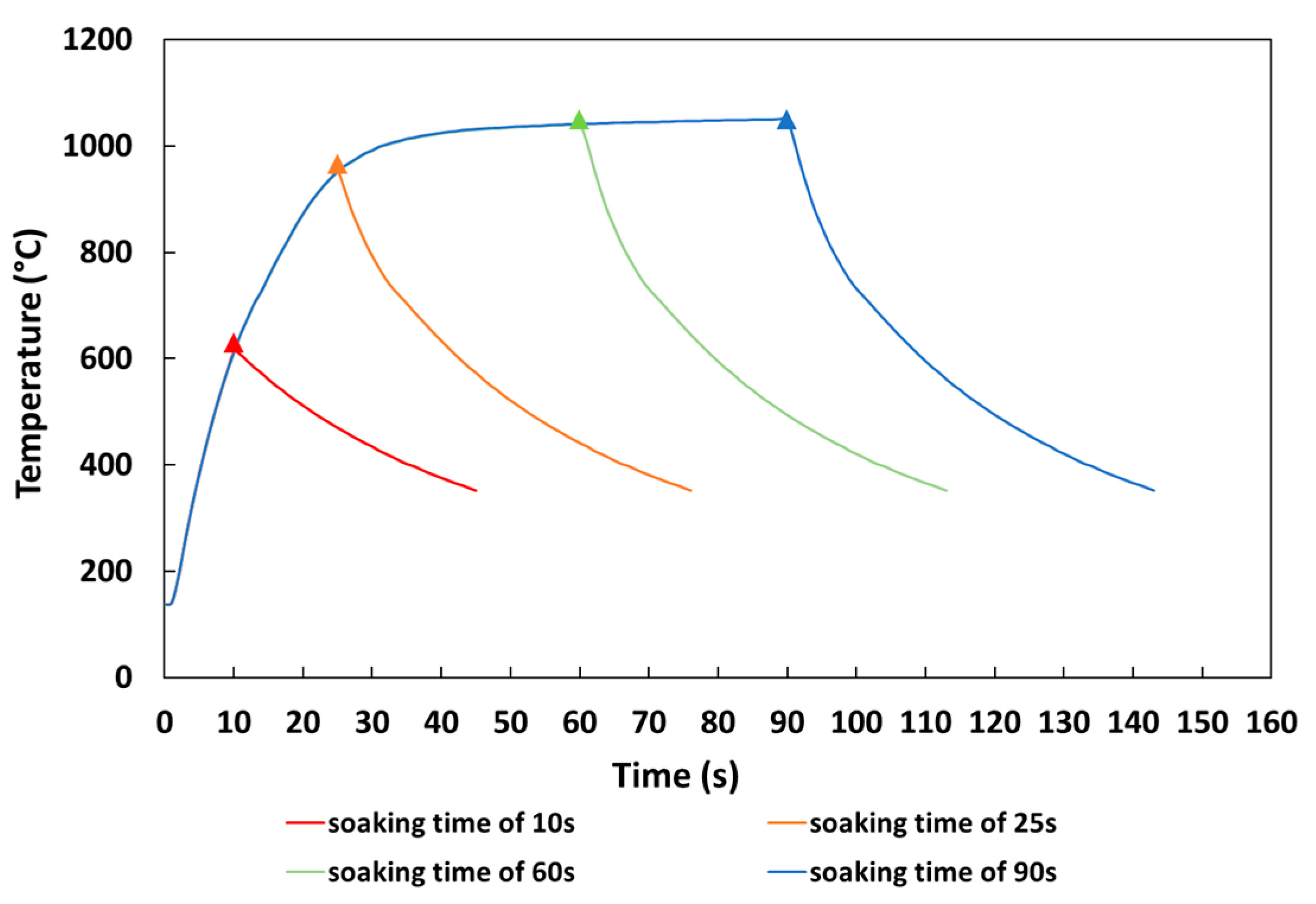
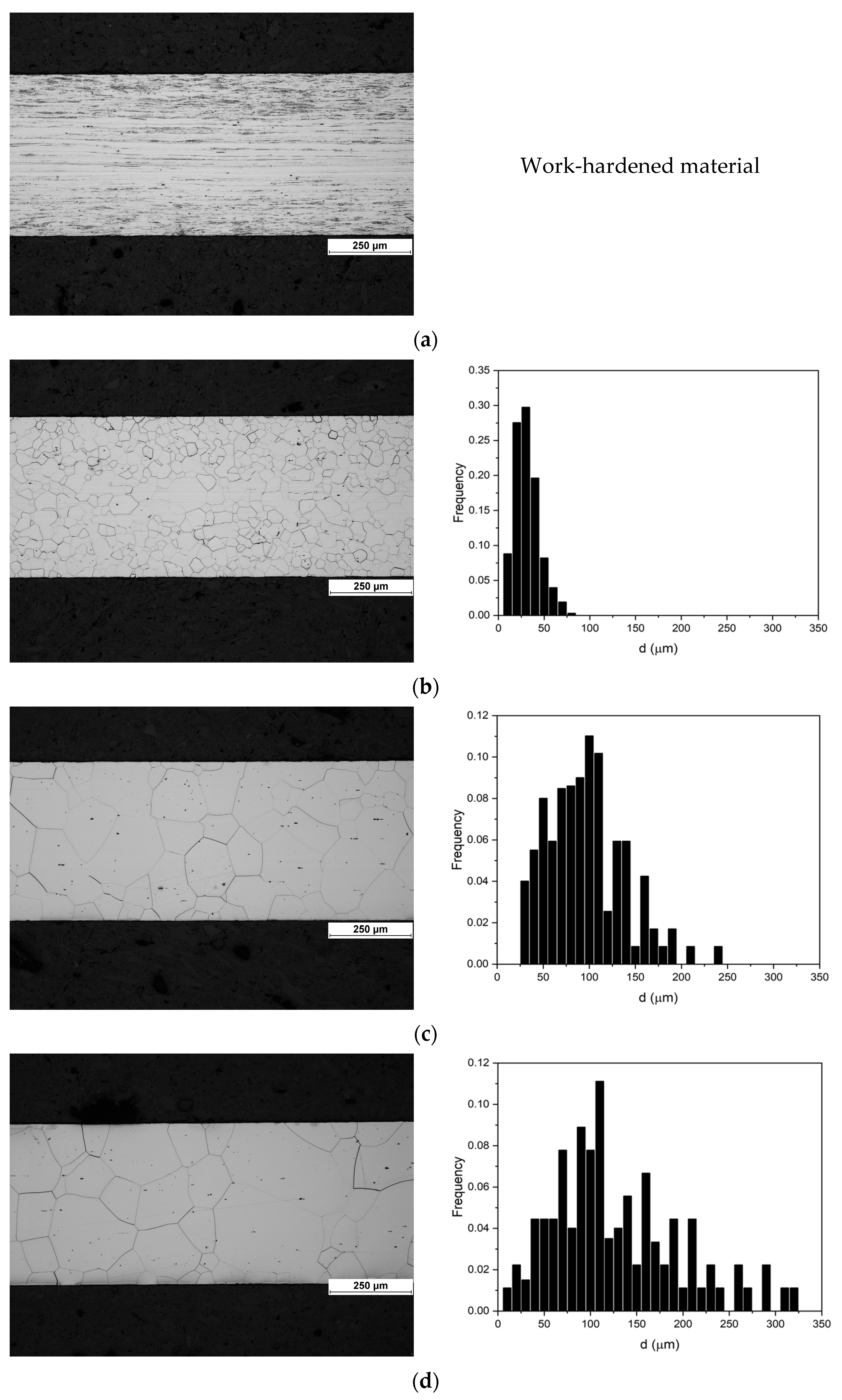
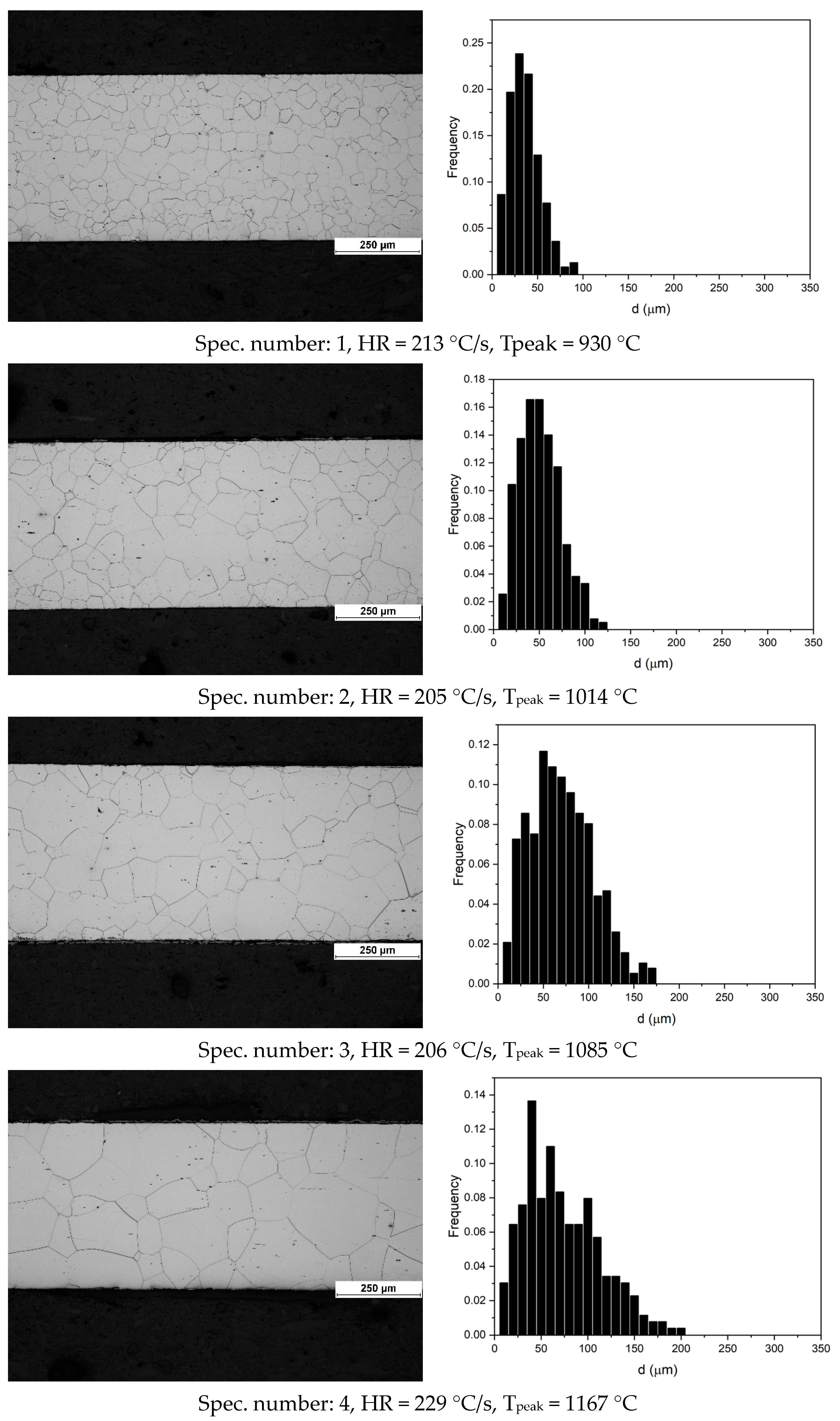
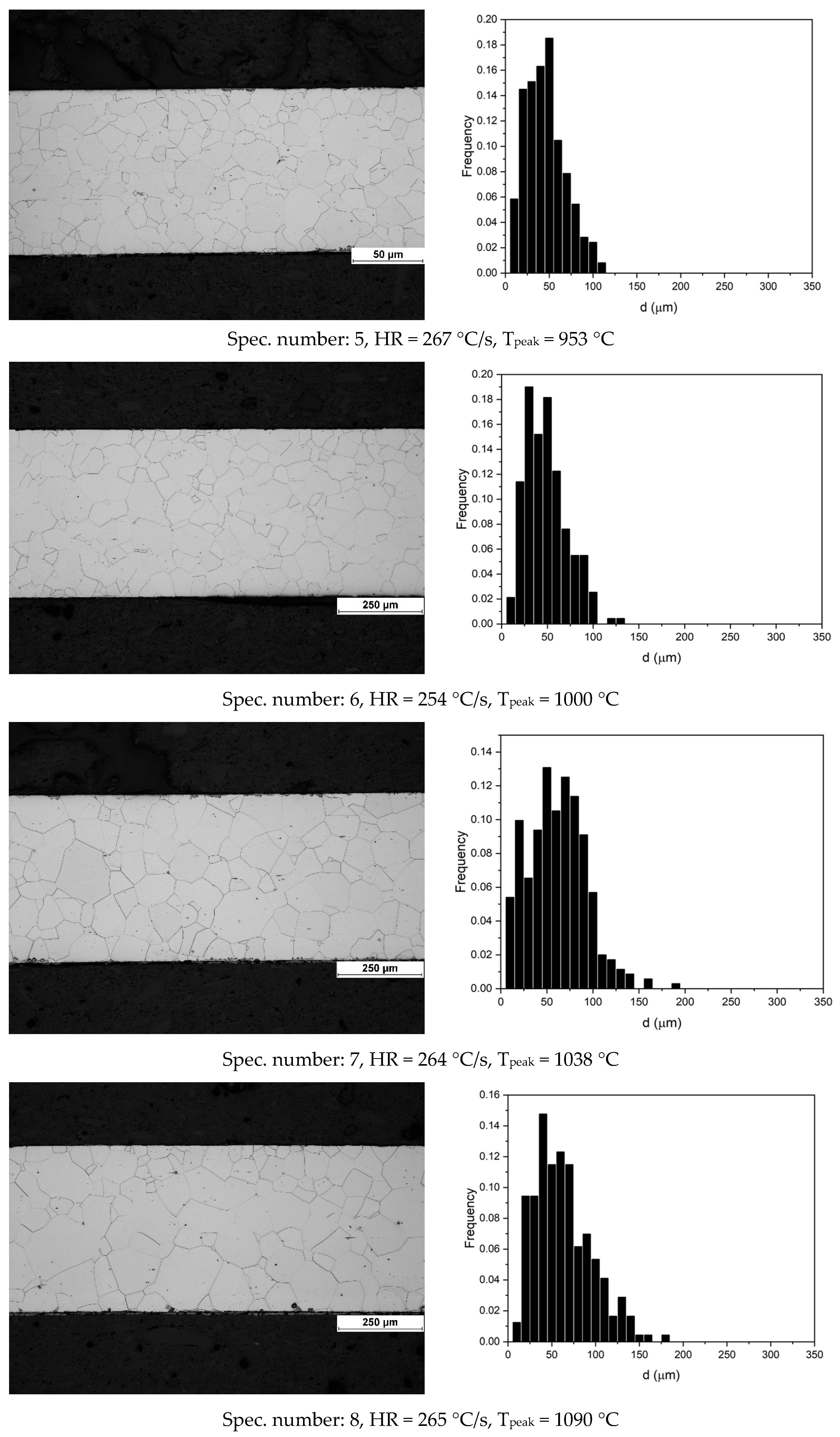
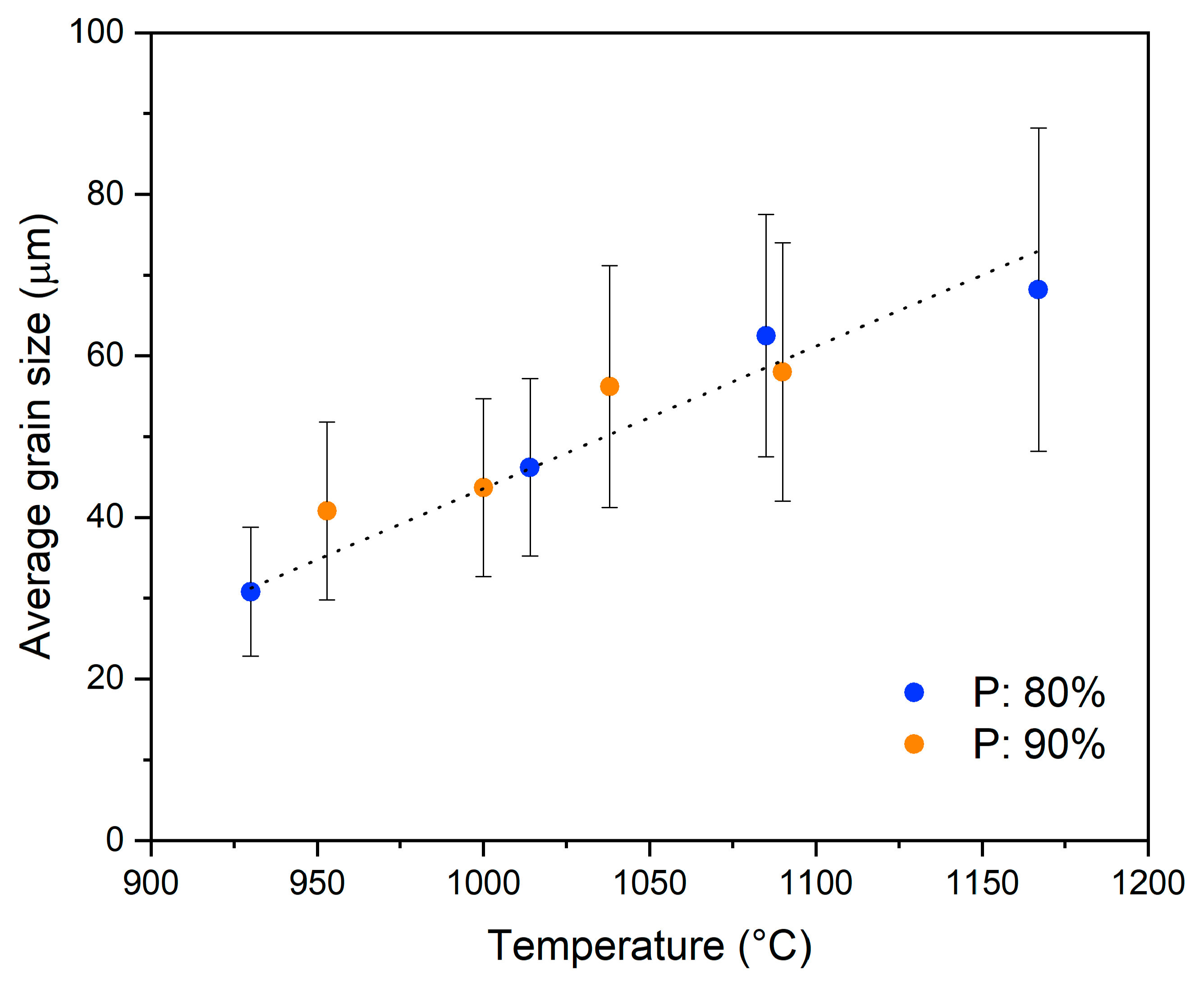
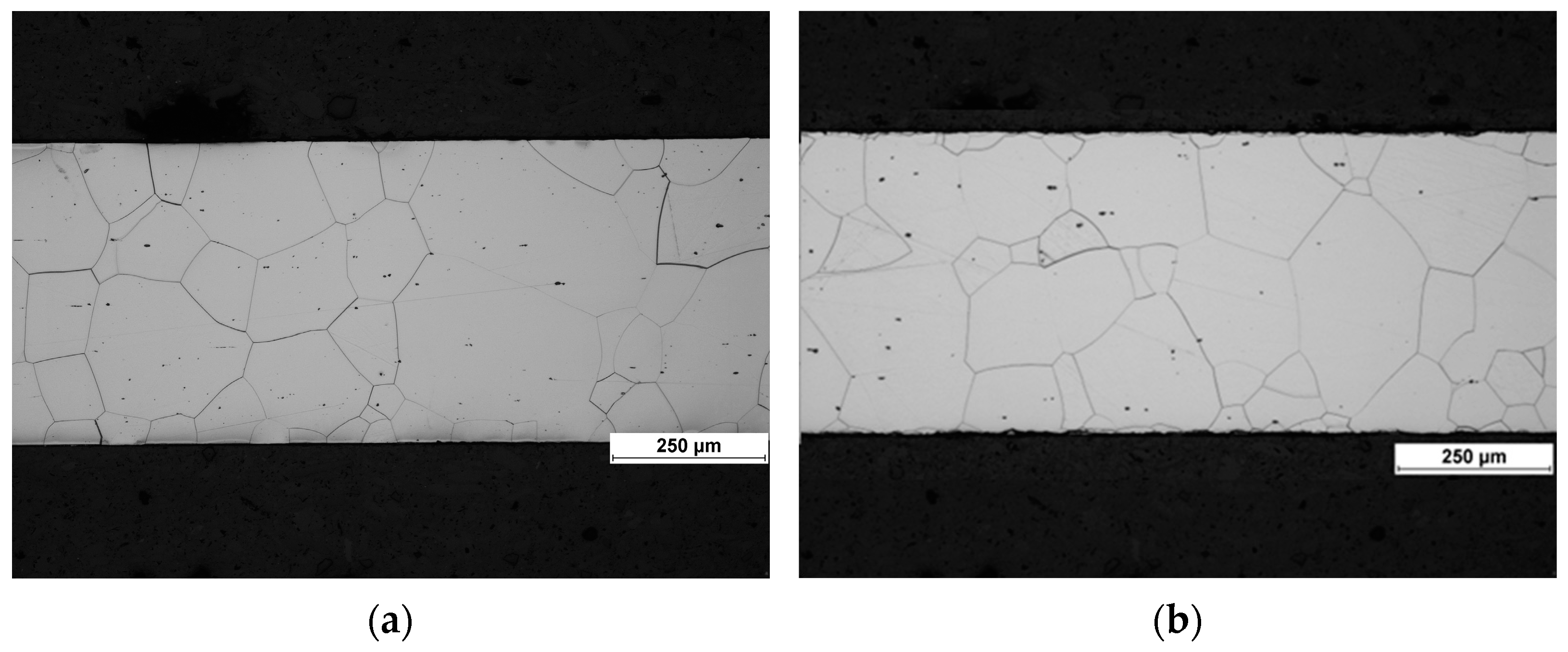
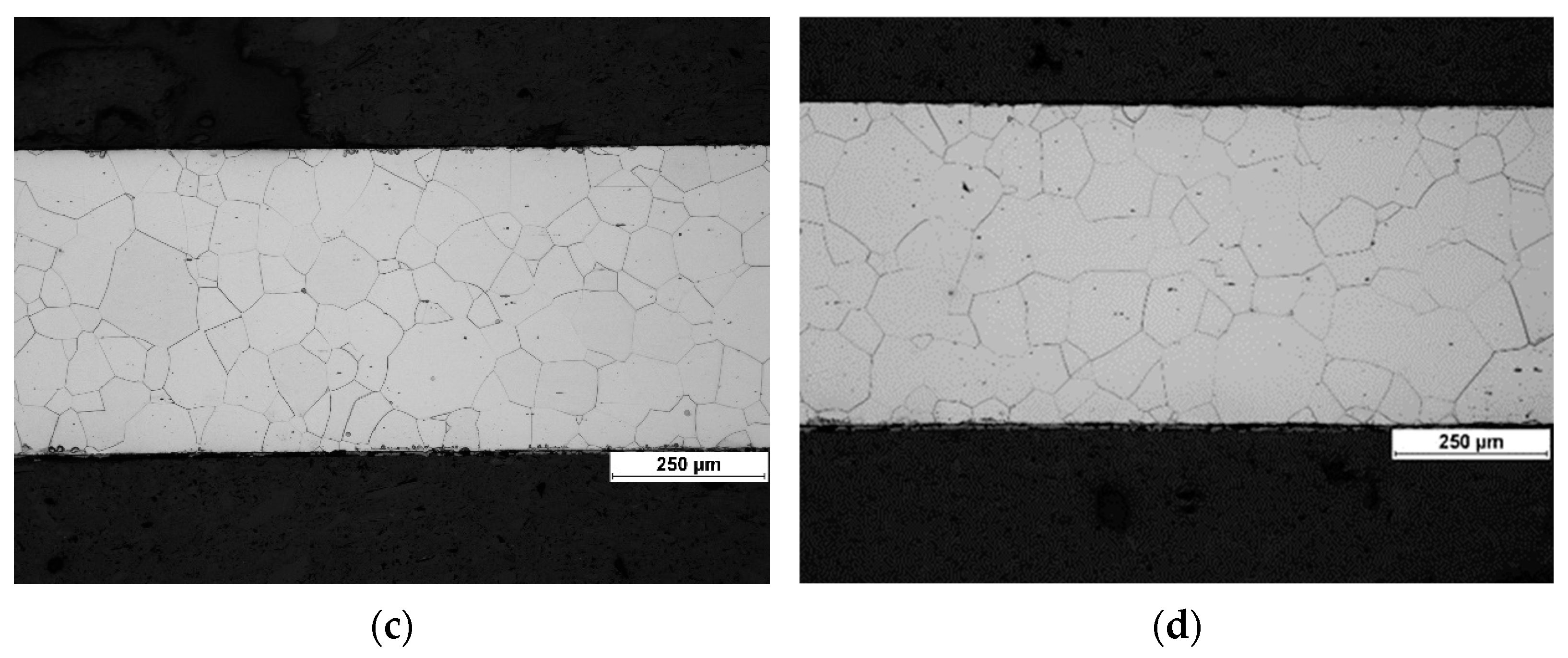
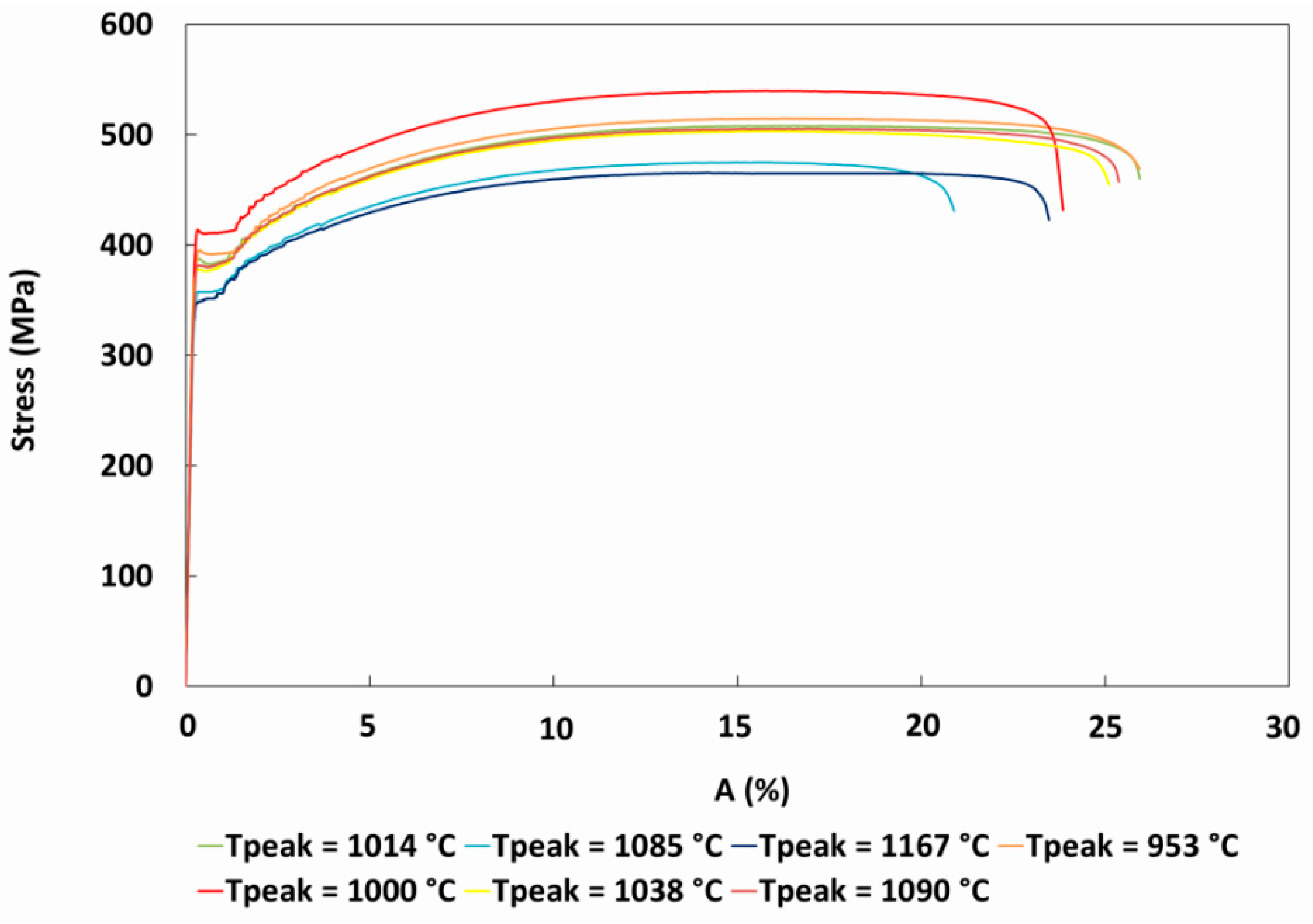
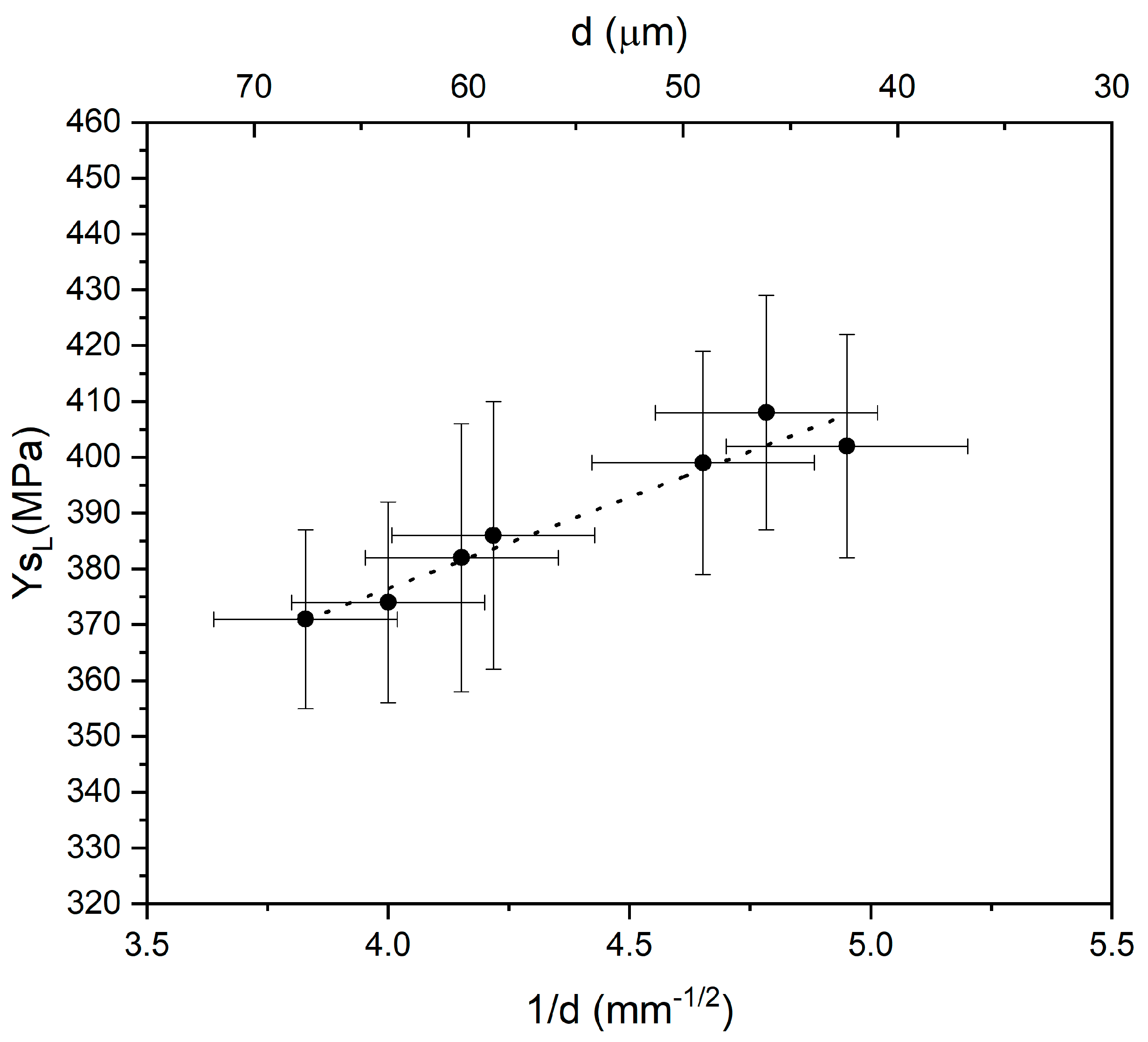
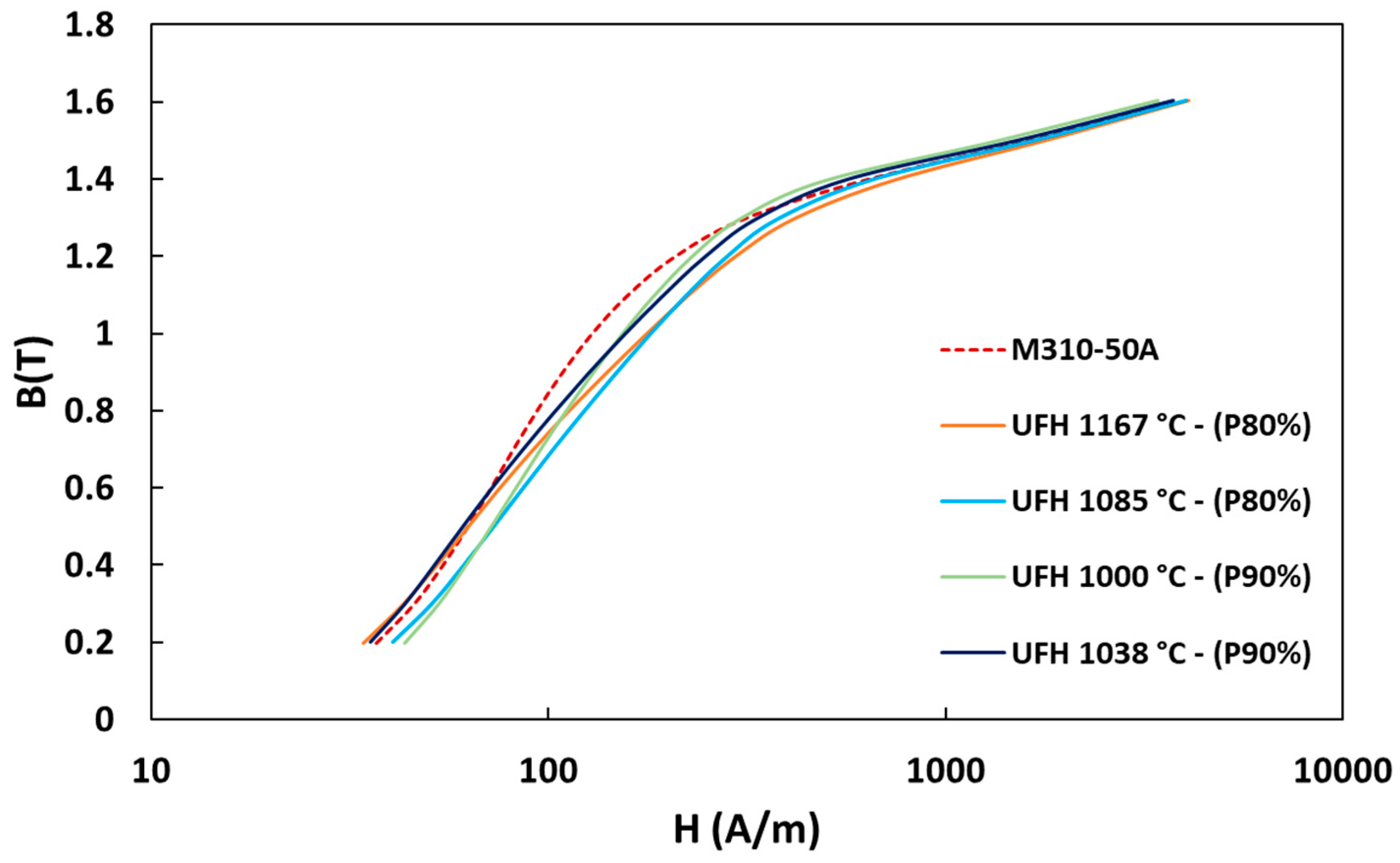

| Steel Grade | C (%) | Si (%) | Al (%) | Mn (%) | N (%) |
|---|---|---|---|---|---|
| NGO_050 | 0.0030 | 2.80 | 1.00 | 0.40 | <0.0030 |
| Specimen Number | P (%) | HR (°C/s) | Tmax (°C) |
|---|---|---|---|
| 1 | 80 | 213 | 930 |
| 2 | 80 | 205 | 1014 |
| 3 | 80 | 206 | 1085 |
| 4 | 80 | 229 | 1167 |
| 5 | 90 | 267 | 953 |
| 6 | 90 | 254 | 1000 |
| 7 | 90 | 264 | 1038 |
| 8 | 90 | 265 | 1090 |
| Soaking Time (s) | Maximum Temperature (°C) | Average Grain Size d (µm) | Std. Dev (µm) | HV1 |
|---|---|---|---|---|
| 10 | 631 | - | - | 279.9 ± 3.5 |
| 25 | 965 | 26.0 | 13.0 | 196.4 ± 2.9 |
| 60 | 1050 | 87.9 | 43.6 | 193.8 ± 3.0 |
| 90 | 1050 | 120.5 | 70.4 | 192.7 ± 2.7 |
| P% | Tpeak (°C) | HR (°C/s) | Average Grain Size d (µm) | Std. Dev. (µm) | HV1 |
|---|---|---|---|---|---|
| 80 | 930 | 213 | 30.8 | 16.5 | 197.8 ± 6.3 |
| 80 | 1014 | 205 | 46.2 | 22.6 | 200.1 ± 0.8 |
| 80 | 1085 | 206 | 62.5 | 32.3 | 201.6 ± 1.3 |
| 80 | 1167 | 229 | 68.2 | 40.4 | 200.3 ± 1.2 |
| 90 | 953 | 267 | 40.8 | 22.3 | 196.6 ± 2.4 |
| 90 | 1000 | 254 | 43.7 | 22.8 | 192.6 ± 2.6 |
| 90 | 1038 | 264 | 56.2 | 30.6 | 199.2 ± 5.5 |
| 90 | 1090 | 265 | 58.0 | 32.7 | 203.1 ± 5.1 |
| Heat Treatment | Process Conditions | Average Grain Size (µm) | HV1 |
|---|---|---|---|
| CA | Tpeak: 1050 °C | 120.5 ± 70.4 | 192.7 ± 2.7 |
| M310-50A | Industrial reference annealing process | 104.7 ± 52.7 | 186.3 ± 2.3 |
| UFH | HR: 206 °C/s, Tpeak: 1038 °C | 56.2 ± 30.6 | 199.2 ± 5.5 |
| UFH | HR: 264 °C/s, Tpeak: 1085 °C | 62.5 ± 32.3 | 201.6 ± 1.3 |
| Tpeak (°C) | Average Grain Size (mm) | Rm (MPa) | YsH (MPa) | YsL (MPa) | A (%) |
|---|---|---|---|---|---|
| 1014 | 46.2 | 528 | 401 | 399 | 25 |
| 1085 | 62.5 | 497 | 376 | 374 | 22 |
| 1167 | 68.2 | 473 | 375 | 371 | 23 |
| 953 | 40.8 | 527 | 406 | 402 | 26 |
| 1000 | 43.7 | 537 | 413 | 408 | 25 |
| 1038 | 56.2 | 510 | 389 | 386 | 24 |
| 1090 | 58.0 | 508 | 383 | 382 | 24 |
| P (%) | Tpeak (°C) | P10 (W/kg) | P15 (W/kg) | J2500 (T) | J5000 (T) | J10,000 (T) | Anisotropy of Loss (%) |
|---|---|---|---|---|---|---|---|
| 80 | 930 | 1.52 | 3.32 | 1.57 | 1.65 | 1.76 | 4.2 |
| 80 | 1014 | 1.54 | 3.36 | 1.56 | 1.65 | 1.76 | 2.0 |
| 80 | 1085 | 1.47 | 3.26 | 1.55 | 1.63 | 1.75 | 1.6 |
| 80 | 1167 | 1.36 | 3.10 | 1.54 | 1.63 | 1.75 | 9.6 |
| 90 | 953 | 1.45 | 3.21 | 1.57 | 1.65 | 1.76 | 3.3 |
| 90 | 1000 | 1.45 | 3.17 | 1.57 | 1.66 | 1.77 | 3.2 |
| 90 | 1038 | 1.37 | 3.13 | 1.54 | 163 | 1.75 | 10.4 |
| 90 | 1090 | 1.53 | 3.32 | 1.56 | 1.65 | 1.76 | 3.3 |
| Industrial reference annealing process | 1.26 | 3.07 | 1.54 | 1.64 | 1.77 | 9.5 | |
Disclaimer/Publisher’s Note: The statements, opinions and data contained in all publications are solely those of the individual author(s) and contributor(s) and not of MDPI and/or the editor(s). MDPI and/or the editor(s) disclaim responsibility for any injury to people or property resulting from any ideas, methods, instructions or products referred to in the content. |
© 2023 by the authors. Licensee MDPI, Basel, Switzerland. This article is an open access article distributed under the terms and conditions of the Creative Commons Attribution (CC BY) license (https://creativecommons.org/licenses/by/4.0/).
Share and Cite
Gaggiotti, M.; Albini, L.; Stornelli, G.; Tiracorrendo, G.; Landi, L.; Di Schino, A. Ultra-Fast Heating Treatment Effect on Microstructure, Mechanical Properties and Magnetic Characteristics of Non-Oriented Grain Electrical Steels. Appl. Sci. 2023, 13, 9833. https://doi.org/10.3390/app13179833
Gaggiotti M, Albini L, Stornelli G, Tiracorrendo G, Landi L, Di Schino A. Ultra-Fast Heating Treatment Effect on Microstructure, Mechanical Properties and Magnetic Characteristics of Non-Oriented Grain Electrical Steels. Applied Sciences. 2023; 13(17):9833. https://doi.org/10.3390/app13179833
Chicago/Turabian StyleGaggiotti, Matteo, Luciano Albini, Giulia Stornelli, Giulia Tiracorrendo, Luca Landi, and Andrea Di Schino. 2023. "Ultra-Fast Heating Treatment Effect on Microstructure, Mechanical Properties and Magnetic Characteristics of Non-Oriented Grain Electrical Steels" Applied Sciences 13, no. 17: 9833. https://doi.org/10.3390/app13179833
APA StyleGaggiotti, M., Albini, L., Stornelli, G., Tiracorrendo, G., Landi, L., & Di Schino, A. (2023). Ultra-Fast Heating Treatment Effect on Microstructure, Mechanical Properties and Magnetic Characteristics of Non-Oriented Grain Electrical Steels. Applied Sciences, 13(17), 9833. https://doi.org/10.3390/app13179833







